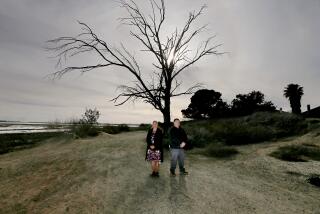Olympics are no contest for these old guys
- Share via
Fascination with the “new” China may be at a sustained peak with the Beijing Olympics, but the Terra Cotta warriors, famous emissaries from old China, are standing on their own in Orange County.
With two months left in its run, the Bowers Museum’s exhibition of ancient Chinese warriors could set an attendance record for the Santa Ana museum by the time it closes Oct. 12, President Peter Keller said Monday. Since opening in mid-May, 106,323 people have seen the show, averaging about 1,350 a day. Because word-of-mouth is the museum’s most effective advertisement, Keller said, he expects attendance to approach its 300-admissions-per-hour limit during the closing two months and possibly top 200,000, outdistancing the Bowers’ previous record, set in 2000 by another exhibit from China, “Secret World of the Forbidden City: Splendors From China’s Imperial Palace.”
What’s billed as the largest group of the 2,200-year-old Terra Cotta warriors ever to leave China has been on display since mid-May. They’ll move on to Atlanta, Houston and Washington, D.C.
The Bowers has hosted several exhibitions from China. In negotiating for “Terra Cotta Warriors: Guardians of China’s First Emperor,” the museum was keen on having its turn coincide with the Olympics.
“We thought if ever American attention would be focused on Chinese culture, it would be during the Olympics,” Keller said, although he couldn’t quantify what the Summer Games have meant for attendance. With limited advertising money, the Bowers bought a local TV spot last week during a “Today” show broadcast including a segment on the exhibition, where regular tickets cost $25 to $27, or $19 to $21 for students and seniors.
On Saturday at the Bowers, however, the Beijing Olympics seemed thousands of years away. Asking museum-goers whether the 2008 sporting extravaganza had kindled their interest in seeing Chinese fighting men from 210 BC was likely to get the same kind of unimpressed and slightly amused look that the painstaking ancient artisans carved into some of the warriors’ faces.
Of dozens buttonholed during a sold-out morning at the museum, not a soul credited the Olympics with having a part in their wanting to see the warriors. The status of Michael Phelps, the swimmer who won eight gold medals in Beijing, apparently still has a way to go before it matches that of Qin Shi Huang, who conquered all of China, ruthlessly reshaped its laws as the nation’s first emperor, built hundreds of palaces, and commissioned the creation of a fighting force of more than 7,000 life-size, lavishly detailed and adorned clay figures to serve him in the afterlife.
“I would have come anyway,” said Pauline Tsai of Claremont. “It’s a legendary thing.”
Madeline Stone is on her high school’s swim team, and the 17-year-old from Manhattan Beach said she’s been avidly watching the exploits of Phelps and other competitors. The Olympics have “added something” to her appreciation of China, “but it’s not the reason to come” for Qin’s ancient warriors, she said while she and her mother, Amy, were whiling away the 20-plus-minute wait to enter the galleries.
Gladys Escobar of Upland said she enjoyed the spectacle China mustered for the Olympics’ opening ceremony. But the Salvadoran immigrant was there to share what her cousin, Lidia Lau of San Bernardino, regarded as an important encounter with the heritage handed down by the Chinese side of her family.
“The day I go to China is going to be a culmination, closing the circle of the family,” she said before entering the exhibition. More than an hour later, she stood near the collections of fragments -- heads, legs and torsos -- that conclude a show featuring 15 of the 1,000 or so fully restored terra cotta figures unearthed so far from trenches near the emperor Qin’s unexcavated tomb.
“It’s amazing, and these are just a fraction,” she said. “How much is still there to be seen is incredible. I can’t wait to actually go and see them -- if God permits, in a year or two. If this is amazing, then seeing them all like that. . . .”
While Lau anticipated wonders in her future, Lydia McIntosh had summoned 14 family members and a close friend to commune with a chapter from their past: her childhood in China as the daughter of Baptist missionaries before the Japanese invasion during World War II forced them back to the U.S.
The 81-year-old from Hacienda Heights gave one of those bemused-warrior looks when asked whether the Olympics were a factore when gathering her clan to see the ancient men of clay.
“I so want them to realize that part of their heritage is from China,” she said. “And when Grandma makes a mandate that all the family shows up, they show up.”
--
More to Read
The biggest entertainment stories
Get our big stories about Hollywood, film, television, music, arts, culture and more right in your inbox as soon as they publish.
You may occasionally receive promotional content from the Los Angeles Times.











